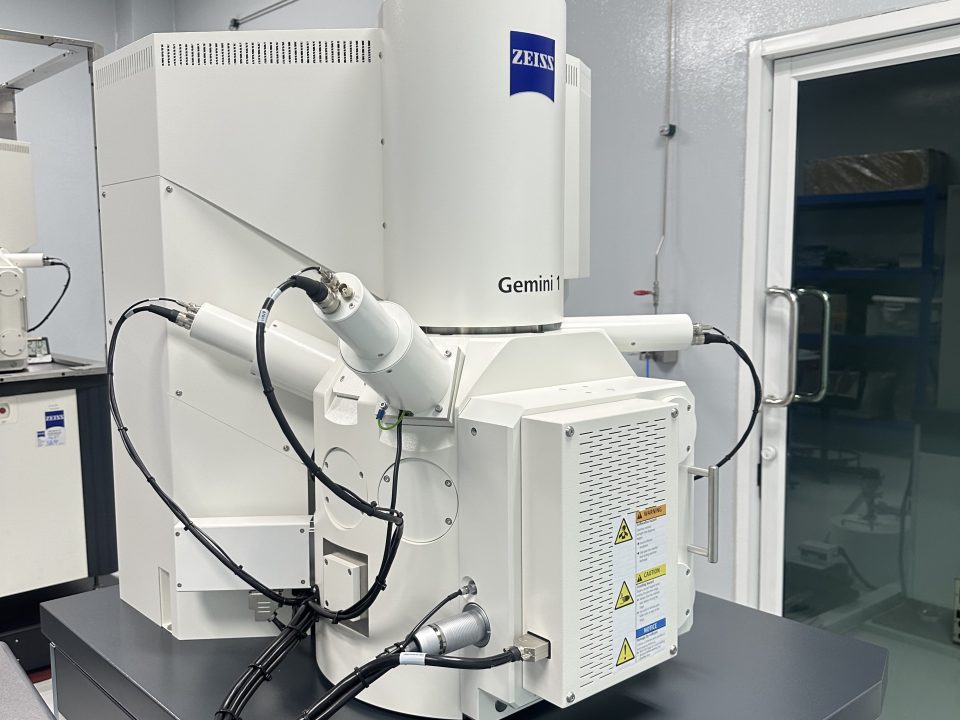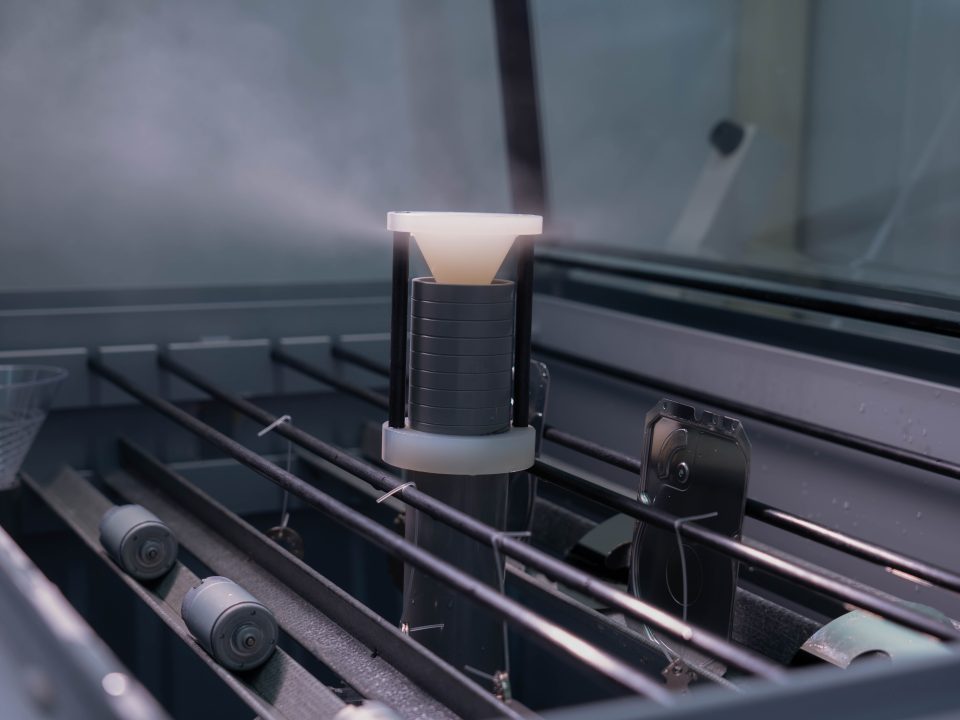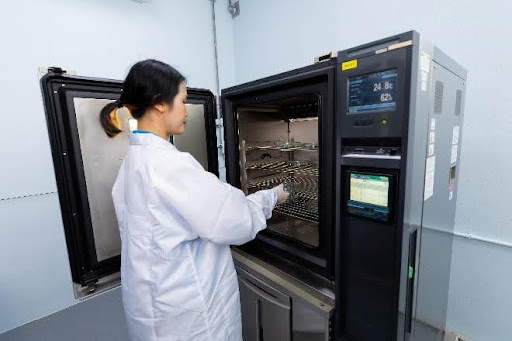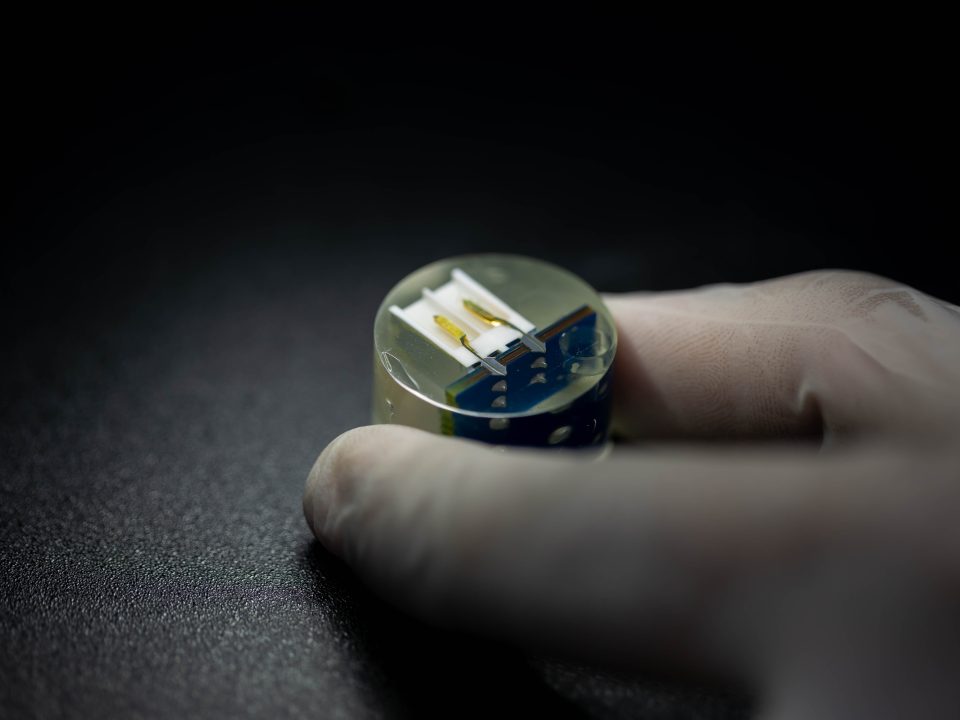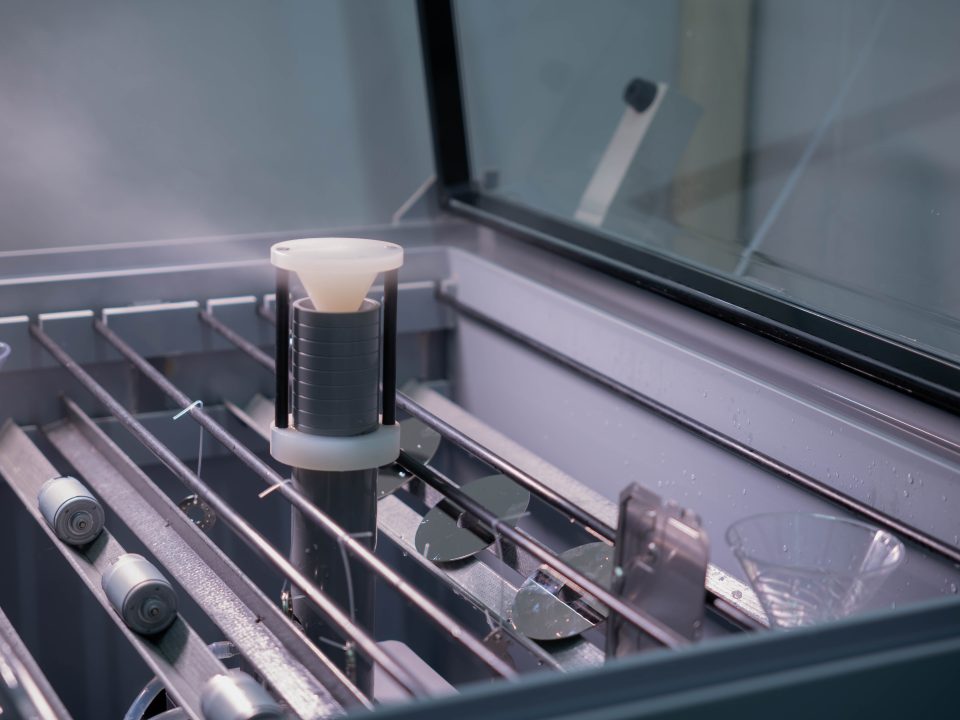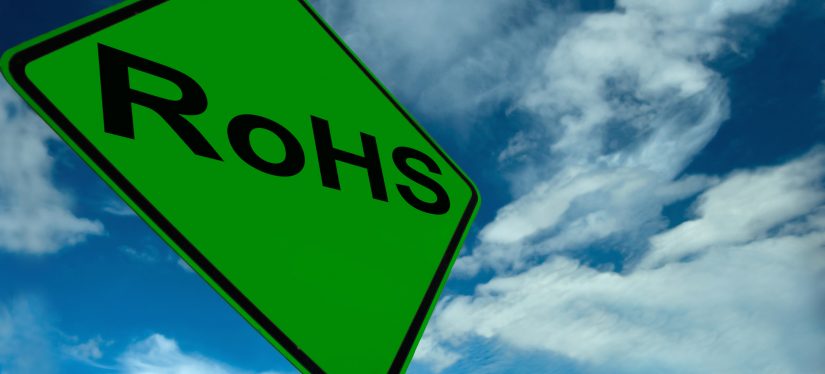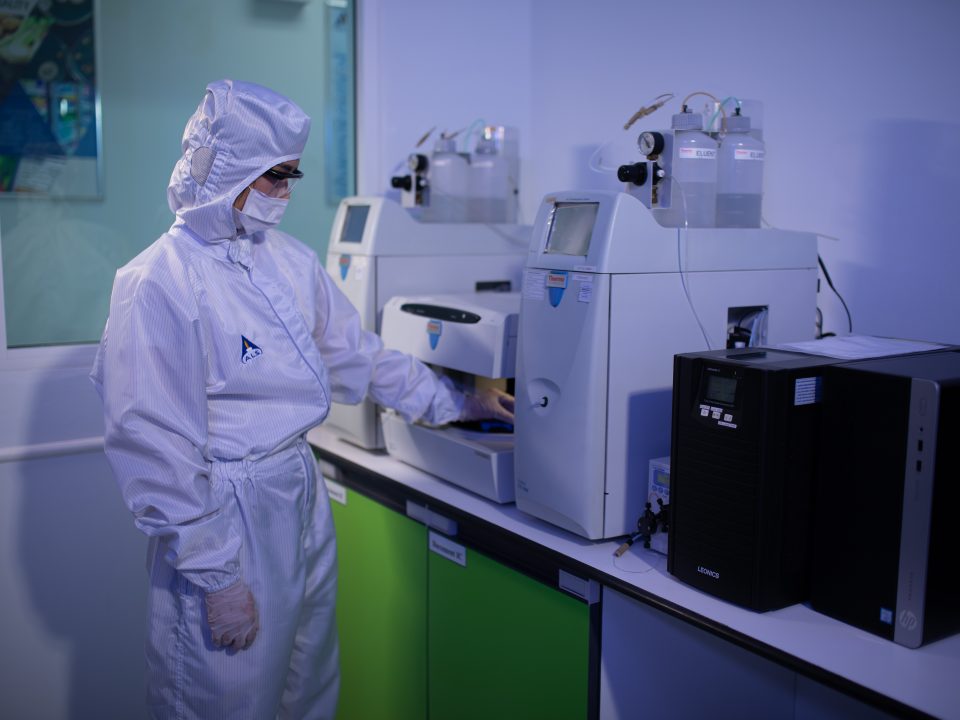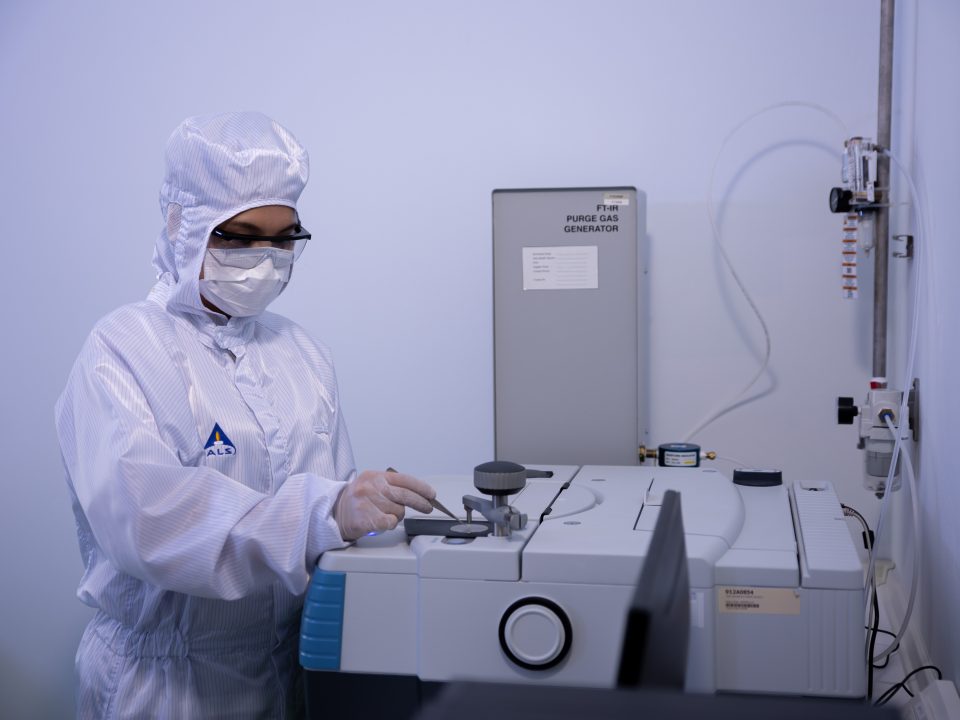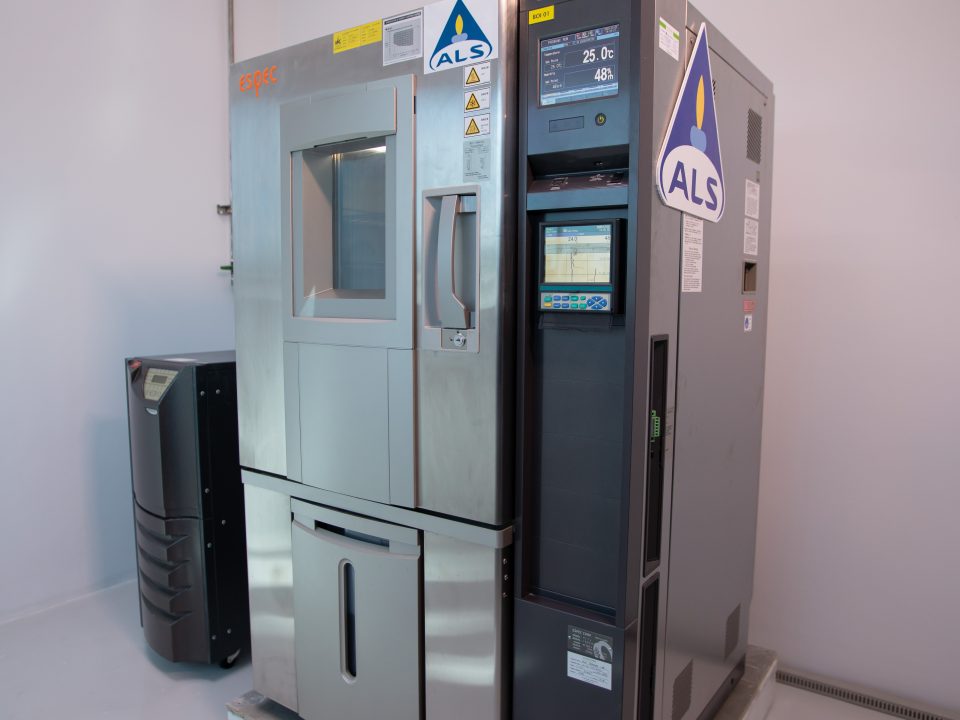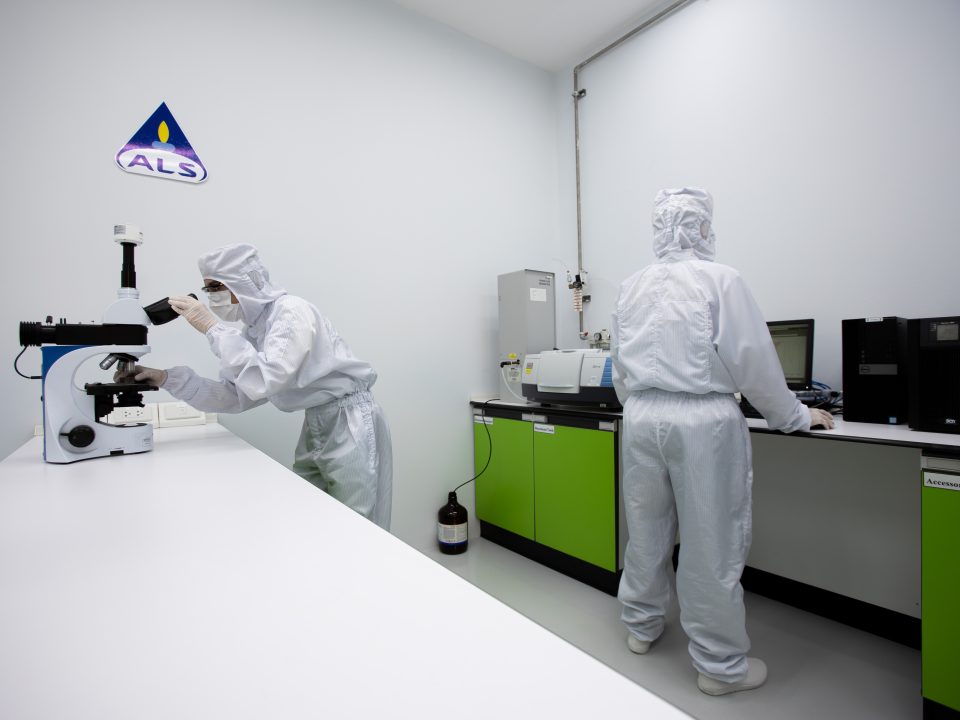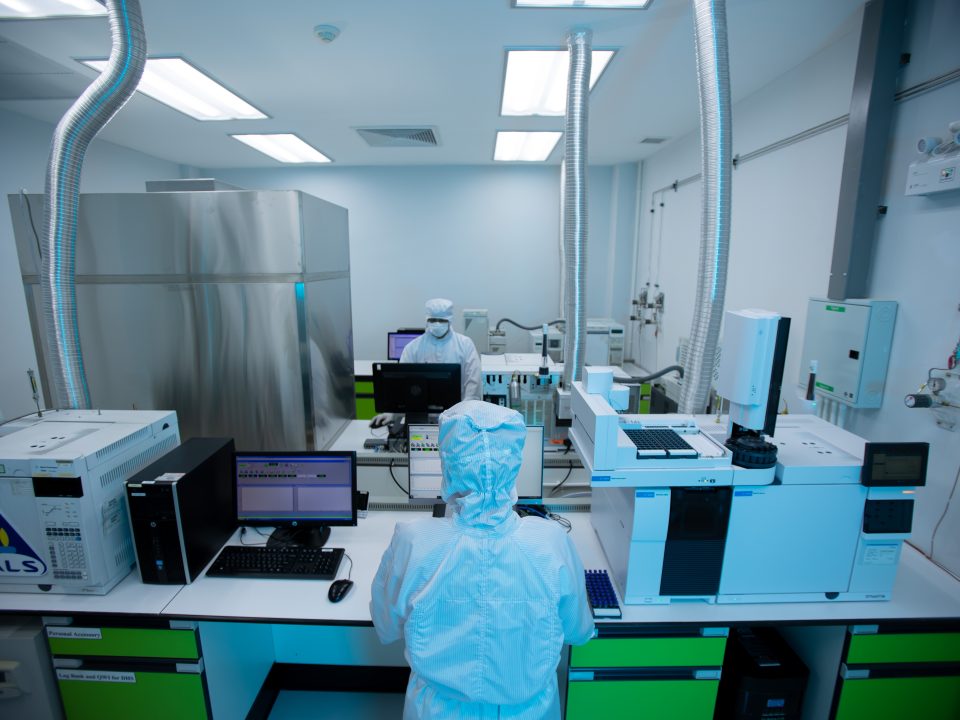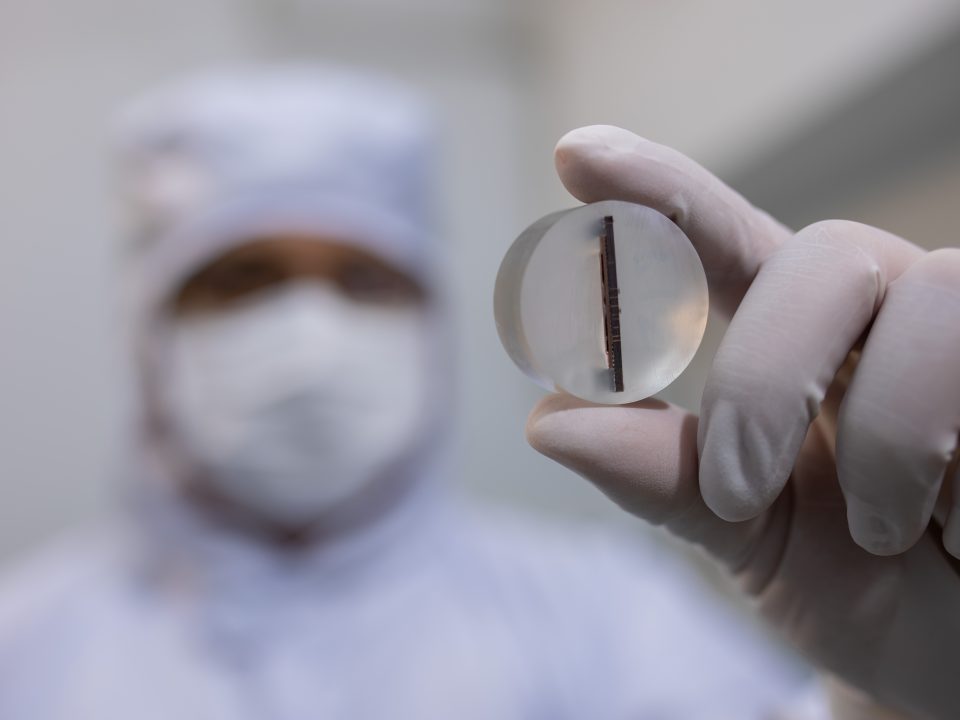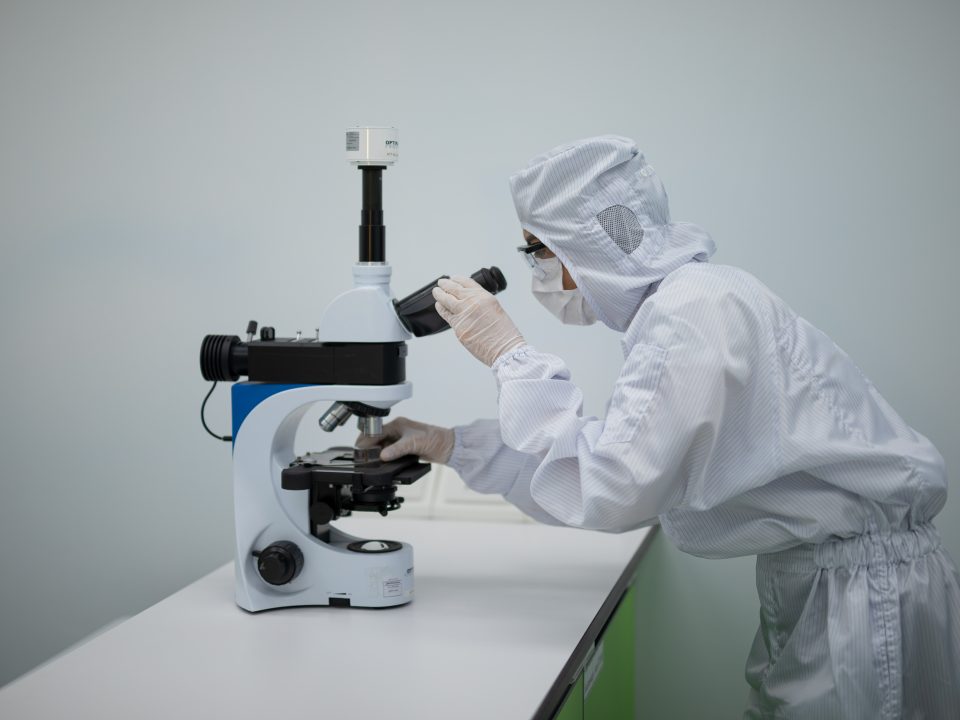April 30, 2025
Published by noiseo at April 30, 2025
Categories
ความเข้าใจพื้นฐานเกี่ยวกับเทคนิค SEM-EDX
ในวงการวิศวกรรม งานวิจัย และการควบคุมคุณภาพในอุตสาหกรรมการผลิต องค์ประกอบของวัสดุถือเป็นปัจจัยสำคัญที่ส่งผลต่อคุณสมบัติและประสิทธิภาพของผลิตภัณฑ์ เทคนิค SEM-EDX (Scanning Electron Microscopy with Energy Dispersive X-ray Spectroscopy) เป็นเครื่องมือวิเคราะห์ขั้นสูงที่ได้รับการยอมรับในระดับสากลสำหรับการวิเคราะห์องค์ประกอบของวัสดุในระดับจุลภาค
เทคนิค SEM-EDX ประกอบด้วยเทคโนโลยีสองส่วนที่ทำงานร่วมกัน ได้แก่:
SEM (Scanning Electron Microscope) – กล้องจุลทรรศน์อิเล็กตรอนแบบสแกน ที่ใช้ลำอิเล็กตรอนในการสร้างภาพจากพื้นผิววัสดุที่มีความละเอียดสูง โดยสามารถให้กำลังขยายได้ถึง 500,000 เท่า และมีความละเอียดในระดับนาโนเมตร ตามมาตรฐาน ISO/TS 24597
EDX (Energy Dispersive X-ray Spectroscopy) – เทคนิคการวิเคราะห์ที่ใช้วัดพลังงานของรังสีเอกซ์ที่ปล่อยออกมาจากวัสดุเมื่อถูกกระตุ้นด้วยลำอิเล็กตรอน ซึ่งช่วยระบุธาตุองค์ประกอบและปริมาณของแต่ละธาตุในตัวอย่าง โดยมีขีดจำกัดการตรวจวัด (Detection Limit) ที่ประมาณ 0.1-1% โดยน้ำหนัก
การผสมผสานเทคโนโลยีทั้งสองนี้ทำให้ SEM-EDX สามารถให้ข้อมูลเชิงลึกทั้งด้านโครงสร้างทางกายภาพและองค์ประกอบทางเคมีของวัสดุในพื้นที่เดียวกัน ซึ่งเป็นข้อมูลที่มีความสำคัญอย่างยิ่งในการวิเคราะห์คุณภาพและการแก้ไขปัญหาในกระบวนการผลิต
หลักการทำงานทางวิทยาศาสตร์ของ SEM-EDX
การทำงานของ SEM-EDX อาศัยหลักการทางฟิสิกส์และเคมีที่ซับซ้อนแต่มีความแม่นยำสูง โดยมีขั้นตอนหลักดังนี้:
การเตรียมตัวอย่าง – ตัวอย่างต้องผ่านกระบวนการเตรียมตามมาตรฐาน ASTM E1508 ซึ่งอาจรวมถึงการขัดผิว การทำความสะอาดด้วยตัวทำละลาย และการเคลือบด้วยวัสดุนำไฟฟ้า (เช่น ทอง หรือคาร์บอน) หากตัวอย่างไม่นำไฟฟ้า
การสร้างภาพด้วย SEM – เมื่อลำอิเล็กตรอนกระทบกับผิววัสดุ จะเกิดปรากฏการณ์การปลดปล่อยอิเล็กตรอนทุติยภูมิ (Secondary Electrons) และอิเล็กตรอนกระเจิงกลับ (Backscattered Electrons) ซึ่งถูกตรวจจับและนำมาสร้างเป็นภาพที่มีความละเอียดสูงของพื้นผิวและโครงสร้างภายในของวัสดุ
การวิเคราะห์ด้วย EDX – เมื่ออิเล็กตรอนพลังงานสูงกระทบกับอะตอมในวัสดุ จะทำให้อิเล็กตรอนในระดับพลังงานชั้นในถูกกระตุ้นให้หลุดออกไป ทำให้เกิดช่องว่างซึ่งจะถูกแทนที่โดยอิเล็กตรอนจากระดับพลังงานที่สูงกว่า ในขณะที่อิเล็กตรอนเคลื่อนที่ลงมาสู่ระดับพลังงานที่ต่ำกว่า จะปลดปล่อยพลังงานในรูปของรังสีเอกซ์ที่มีพลังงานจำเพาะสำหรับแต่ละธาตุ
การระบุธาตุและปริมาณ – เครื่องตรวจวัด EDX จะวัดพลังงานของรังสีเอกซ์ที่ปล่อยออกมา และนำมาวิเคราะห์เปรียบเทียบกับค่ามาตรฐานเพื่อระบุชนิดของธาตุและปริมาณเชิงสัมพัทธ์ โดยมีซอฟต์แวร์ที่ใช้อัลกอริทึมการประมวลผลตามมาตรฐาน ISO 22309 และ ASTM E1508
ความแม่นยำของการวิเคราะห์ด้วย SEM-EDX ขึ้นอยู่กับหลายปัจจัย เช่น คุณภาพของการเตรียมตัวอย่าง ความละเอียดของเครื่องมือ และความเชี่ยวชาญของผู้วิเคราะห์ โดยทั่วไปสามารถให้ความแม่นยำในเชิงปริมาณที่ ±1-2% สำหรับธาตุหลัก และ ±5-10% สำหรับธาตุที่มีปริมาณน้อย (trace elements)
ประโยชน์ด้านวิศวกรรมและการควบคุมคุณภาพของ SEM-EDX
เทคนิค SEM-EDX มีคุณสมบัติหลายประการที่ทำให้เป็นเครื่องมือที่มีประสิทธิภาพสูงในการวิเคราะห์วัสดุ:
ความแม่นยำในระดับจุลภาค – สามารถวิเคราะห์องค์ประกอบในพื้นที่เล็กถึงระดับไมโครเมตรหรือน้อยกว่า ทำให้สามารถตรวจสอบความแตกต่างขององค์ประกอบในโครงสร้างระดับจุลภาค เช่น รอยต่อ หรือบริเวณที่มีความเข้มข้นของธาตุแตกต่างกัน
การวิเคราะห์แบบไม่ทำลาย – เทคนิคนี้เป็นการวิเคราะห์ที่ไม่ทำลายโครงสร้างหลักของตัวอย่าง ทำให้สามารถนำตัวอย่างไปวิเคราะห์ด้วยเทคนิคอื่นเพิ่มเติมได้ แม้จะต้องเตรียมตัวอย่างบางประเภทก่อนการวิเคราะห์
การวิเคราะห์แบบบูรณาการ – การรวมระบบการสร้างภาพและการวิเคราะห์องค์ประกอบไว้ในเครื่องเดียวกัน ทำให้สามารถสหสัมพันธ์ข้อมูลทางกายภาพและทางเคมีได้อย่างมีประสิทธิภาพ
ความรวดเร็วในการวิเคราะห์ – สามารถให้ผลการวิเคราะห์เบื้องต้นได้ภายในเวลาไม่กี่นาที และการวิเคราะห์โดยละเอียดภายใน 1-2 ชั่วโมง ซึ่งช่วยลดเวลาในกระบวนการควบคุมคุณภาพและการแก้ไขปัญหา
ความยืดหยุ่นในการวิเคราะห์ – สามารถวิเคราะห์วัสดุได้หลากหลายประเภท ทั้งโลหะ พอลิเมอร์ เซรามิก วัสดุผสม และวัสดุกึ่งตัวนำ ทำให้เหมาะกับอุตสาหกรรมหลายประเภท
ข้อจำกัดที่ควรพิจารณา
แม้ SEM-EDX จะเป็นเครื่องมือที่มีประสิทธิภาพสูง แต่ก็มีข้อจำกัดที่ผู้ใช้ควรตระหนัก:
ขีดจำกัดในการตรวจวัดธาตุเบา – ระบบ EDX มักมีข้อจำกัดในการตรวจวัดธาตุที่มีเลขอะตอมต่ำกว่า 11 (โซเดียม) และไม่สามารถตรวจวัดธาตุเบาบางชนิด เช่น ไฮโดรเจน ฮีเลียม และลิเทียม ได้
ความแม่นยำในเชิงปริมาณ – แม้จะสามารถให้ข้อมูลเชิงปริมาณได้ แต่อาจมีความคลาดเคลื่อนสูงกว่าเทคนิคเฉพาะทางอื่นๆ เช่น XRF (X-ray Fluorescence) หรือ ICP-MS (Inductively Coupled Plasma Mass Spectrometry)
การเตรียมตัวอย่าง – ตัวอย่างต้องมีพื้นผิวที่เรียบและสะอาด จึงอาจต้องมีการเตรียมตัวอย่างที่ซับซ้อนในบางกรณี ซึ่งอาจส่งผลต่อโครงสร้างของตัวอย่างได้
ค่าใช้จ่าย – เครื่องมือ SEM-EDX มีราคาสูงและต้องการผู้เชี่ยวชาญในการใช้งานและบำรุงรักษา ทำให้มีต้นทุนการวิเคราะห์ที่สูงกว่าเทคนิคพื้นฐานอื่นๆ
การประยุกต์ใช้ SEM-EDX ในภาคอุตสาหกรรม
เทคนิค SEM-EDX มีการประยุกต์ใช้อย่างกว้างขวางในหลากหลายอุตสาหกรรม ดังนี้:
อุตสาหกรรมโลหะและวัสดุกรณีศึกษา: การวิเคราะห์ความล้มเหลวของท่อที่เกิดการแตกร้าวในระบบส่งน้ำมัน โดยพบการแยกตัวของซัลไฟด์บริเวณรอยแตกซึ่งเป็นสาเหตุของความเสียหาย (ที่มา: Journal of Failure Analysis and Prevention, Vol. 18, 2018)
การตรวจสอบองค์ประกอบของโลหะผสมตามมาตรฐาน ASTM E1508
การวิเคราะห์ความไม่สม่ำเสมอของธาตุในชิ้นงาน เช่น การแยกตัวของเฟส (Phase Segregation)
การตรวจสอบการปนเปื้อนที่ผิวและรอยต่อระหว่างชั้นเคลือบ
อุตสาหกรรมอิเล็กทรอนิกส์กรณีศึกษา: การตรวจพบสาเหตุของการล้มเหลวในการทำงานของ MEMS Sensor เนื่องจากการปนเปื้อนของซิลิกอนในชั้นเคลือบทองที่ใช้ในการเชื่อมต่อ (ที่มา: IEEE Transactions on Device and Materials Reliability, Vol. 20, 2020)
การวิเคราะห์ความบกพร่องในแผงวงจรและชิ้นส่วนอิเล็กทรอนิกส์
การตรวจสอบคุณภาพของจุดเชื่อมต่อและการบัดกรี
การวิเคราะห์องค์ประกอบของวัสดุกึ่งตัวนำตามมาตรฐาน IEC 61249
อุตสาหกรรมยานยนต์และการบิน
การวิเคราะห์ความล้มเหลวของชิ้นส่วนยานยนต์และอากาศยาน
การตรวจสอบคุณภาพของรอยเชื่อมและจุดต่อระหว่างวัสดุต่างชนิด
การวิเคราะห์การสึกหรอและการกัดกร่อนตามมาตรฐาน SAE J1757
การวิจัยและพัฒนาวัสดุใหม่
การศึกษาโครงสร้างและองค์ประกอบของวัสดุนาโนและวัสดุก้าวหน้า
การวิเคราะห์การกระจายตัวของอนุภาคในวัสดุผสม
การตรวจสอบความสม่ำเสมอของชั้นเคลือบบางในอุปกรณ์อิเล็กทรอนิกส์และโซลาร์เซลล์
การเลือกใช้บริการวิเคราะห์ SEM-EDX จากผู้เชี่ยวชาญ
การวิเคราะห์ด้วยเทคนิค SEM-EDX ที่มีประสิทธิภาพต้องอาศัยทั้งเครื่องมือที่มีความแม่นยำสูงและผู้เชี่ยวชาญที่มีประสบการณ์ในการวิเคราะห์และแปลผล ปัจจัยที่ควรพิจารณาในการเลือกใช้บริการวิเคราะห์ประกอบด้วย:
การรับรองมาตรฐาน – ห้องปฏิบัติการที่ได้รับการรับรองมาตรฐาน ISO/IEC 17025 ซึ่งเป็นมาตรฐานสากลสำหรับห้องปฏิบัติการทดสอบและสอบเทียบ
เครื่องมือและเทคโนโลยี – เครื่อง SEM-EDX ที่ทันสมัยและได้รับการบำรุงรักษาอย่างสม่ำเสมอ มีความละเอียดและความแม่นยำสูง
ประสบการณ์และความเชี่ยวชาญ – ทีมนักวิทยาศาสตร์และวิศวกรที่มีความเชี่ยวชาญในการวิเคราะห์วัสดุและการแปลผลข้อมูล SEM-EDX
การรายงานผลที่ครบถ้วน – รายงานผลการวิเคราะห์ที่มีข้อมูลครบถ้วน ทั้งภาพถ่าย SEM สเปกตรัม EDX การวิเคราะห์เชิงปริมาณ และการแปลผล
Alstesting เป็นหนึ่งในผู้ให้บริการวิเคราะห์ด้วยเทคนิค SEM-EDX ที่ได้รับการรับรองมาตรฐาน ISO/IEC 17025 และมีประสบการณ์ในการวิเคราะห์วัสดุมากกว่า 40 ปี บริการครอบคลุมการวิเคราะห์วัสดุหลากหลายประเภท ทั้งสำหรับภาคการวิจัย สถาบันการศึกษา และภาคอุตสาหกรรม
ด้วยบุคลากรที่มีความเชี่ยวชาญและเครื่องมือวิเคราะห์ที่ทันสมัย Alstesting สามารถให้บริการวิเคราะห์ที่มีความแม่นยำสูงและให้คำปรึกษาเชิงเทคนิคเพื่อช่วยในการแก้ไขปัญหาและพัฒนาคุณภาพของผลิตภัณฑ์อย่างมีประสิทธิภาพ
สรุป
เทคนิค SEM-EDX เป็นเครื่องมือวิเคราะห์ที่มีประสิทธิภาพสูงในการตรวจสอบโครงสร้างและองค์ประกอบของวัสดุในระดับจุลภาค ด้วยความสามารถในการให้ข้อมูลทั้งด้านโครงสร้างทางกายภาพและองค์ประกอบทางเคมีในเครื่องเดียวกัน ทำให้เป็นเครื่องมือที่มีความสำคัญในการควบคุมคุณภาพและการวิจัยพัฒนาในหลากหลายอุตสาหกรรม
การเลือกใช้บริการวิเคราะห์จากห้องปฏิบัติการที่ได้มาตรฐานและมีความเชี่ยวชาญ จะช่วยให้ได้ผลการวิเคราะห์ที่มีความน่าเชื่อถือและสามารถนำไปใช้ในการพัฒนาและแก้ไขปัญหาได้อย่างมีประสิทธิภาพ
Read moreApril 25, 2025
Published by noiseo at April 25, 2025
Categories
Salt Spray Test คืออะไร?
การทดสอบ Salt Spray Test เป็นวิธีมาตรฐานในการประเมินความสามารถในการต้านทานการกัดกร่อนของโลหะและวัสดุเคลือบผิว กระบวนการนี้เป็นที่ยอมรับในระดับสากลและถือเป็นขั้นตอนสำคัญในการรับรองคุณภาพของผลิตภัณฑ์โลหะ เช่น อุปกรณ์ยึดต่างๆ ชิ้นส่วนยานยนต์ และวัสดุโครงสร้างทางวิศวกรรม
การทดสอบนี้ดำเนินการโดยการจำลองสภาพแวดล้อมที่มีความเข้มข้นของไอเกลือสูง ซึ่งเป็นสภาวะที่เร่งให้เกิดการกัดกร่อนในระยะเวลาอันสั้น แทนที่จะต้องรอเป็นเดือนหรือปีในสภาพการใช้งานจริง ผลการทดสอบนี้สามารถคาดการณ์อายุการใช้งานและประสิทธิภาพของวัสดุเมื่อต้องเผชิญกับสภาพแวดล้อมที่มีการกัดกร่อนได้อย่างแม่นยำ
ความจำเป็นของการทดสอบ Salt Spray สำหรับผลิตภัณฑ์โลหะ
โลหะทุกชนิดมีความเสี่ยงต่อการเกิดสนิมและการเสื่อมสภาพเมื่อสัมผัสกับสภาพแวดล้อมที่มีความชื้นและมีสารกัดกร่อน โดยเฉพาะอย่างยิ่งในประเทศไทยที่มีสภาพอากาศร้อนชื้นและพื้นที่ติดทะเลหลายส่วน ซึ่งมีความเข้มข้นของไอเกลือในบรรยากาศสูง
การเกิดสนิมไม่เพียงส่งผลต่อความสวยงามของผลิตภัณฑ์แต่ยังลดทอนคุณสมบัติทางกลที่สำคัญ เช่น:
ความแข็งแรงของโครงสร้าง
ความต้านทานต่อแรงดึง
ความทนทานต่อแรงกระแทก
อายุการใช้งานของวัสดุ
องค์กรมาตรฐานสากล เช่น ISO, ASTM และ JIS ได้กำหนดเกณฑ์การทดสอบ Salt Spray ไว้เพื่อให้ผลิตภัณฑ์มีคุณภาพตามมาตรฐานที่กำหนด การไม่ผ่านการทดสอบนี้อาจส่งผลให้ผลิตภัณฑ์ไม่ได้รับการรับรองมาตรฐานและถูกปฏิเสธจากตลาด ทำให้เกิดความเสียหายทางธุรกิจอย่างมีนัยสำคัญ
กระบวนการทดสอบ Salt Spray ตามมาตรฐานสากล
การทดสอบ Salt Spray ดำเนินการตามขั้นตอนที่เป็นระบบและมีความแม่นยำสูง ประกอบด้วย:
การเตรียมตัวอย่างทดสอบ: ชิ้นงานโลหะจะถูกทำความสะอาดตามมาตรฐาน ISO 8407 เพื่อกำจัดสิ่งปนเปื้อนที่อาจส่งผลต่อความแม่นยำของการทดสอบ จากนั้นจัดวางในตำแหน่งที่เหมาะสมภายในห้องทดสอบ (Salt Spray Chamber)
การควบคุมสภาวะทดสอบ: ระบบจะทำการฉีดพ่นละอองสารละลายโซเดียมคลอไรด์(NaCl) ที่มีความเข้มข้น 5% ±0.5% ในอุณหภูมิควบคุม 35°C ±2°C และค่า pH ระหว่าง 6.5-7.2 เพื่อสร้างสภาวะการกัดกร่อนที่เป็นมาตรฐาน
ระยะเวลาทดสอบตามมาตรฐาน: การทดสอบจะดำเนินการตามระยะเวลาที่กำหนดโดยมาตรฐานสากล ดังนี้:
48 ชั่วโมง: มาตรฐานขั้นพื้นฐานสำหรับผลิตภัณฑ์ทั่วไป (ISO 9227)
96 ชั่วโมง: เกณฑ์มาตรฐานสำหรับอุตสาหกรรม (ASTM B117)
240 ชั่วโมงขึ้นไป: มาตรฐานสูงสำหรับผลิตภัณฑ์ที่ต้องใช้งานในสภาพแวดล้อมที่รุนแรง (JIS Z 2371)
การวิเคราะห์ผลทดสอบ: เมื่อครบกำหนดเวลา ชิ้นงานจะถูกนำมาประเมินตามเกณฑ์มาตรฐานด้วยการตรวจวัด:
ปริมาณพื้นที่ที่เกิดสนิม (ต้องไม่เกินค่าที่กำหนด)
การยึดเกาะของชั้นเคลือบ (ต้องไม่มีการหลุดลอกหรือพอง)
การวัดความหนาของชั้นเคลือบที่เหลืออยู่ (ต้องไม่ลดลงเกินเกณฑ์ที่กำหนด)
การทดสอบทางกลหลังการทดสอบการกัดกร่อน (ต้องไม่สูญเสียคุณสมบัติเชิงกล)
ผลกระทบทางธุรกิจจากการไม่ผ่านการทดสอบ
ในบริบทของอุตสาหกรรมการส่งออก การไม่ผ่านการทดสอบ Salt Spray Test มีผลกระทบที่สำคัญต่อธุรกิจหลายประการ:
การไม่ผ่านการรับรองมาตรฐาน: ผลิตภัณฑ์โลหะที่ไม่ผ่านการทดสอบจะไม่ได้รับการรับรองตามมาตรฐานสากล ส่งผลให้ไม่สามารถจำหน่ายในตลาดที่มีข้อกำหนดด้านคุณภาพสูง
การถูกปฏิเสธสินค้าจากลูกค้า: กรณีศึกษาจากผู้ส่งออกชิ้นส่วนโลหะแสดงให้เห็นว่า การส่งมอบผลิตภัณฑ์ที่ไม่ผ่านการทดสอบอาจนำไปสู่การถูกปฏิเสธสินค้าทั้งหมด และต้องแบกรับต้นทุนการขนส่งสินค้ากลับ
ความเสียหายต่อภาพลักษณ์: บริษัทที่มีประวัติการส่งมอบผลิตภัณฑ์ที่ไม่ได้มาตรฐานจะได้รับความเชื่อมั่นลดลงในระยะยาว ส่งผลต่อโอกาสทางธุรกิจในอนาคต
ค่าใช้จ่ายในการแก้ไขและปรับปรุง: การต้องนำผลิตภัณฑ์กลับมาปรับปรุงหลังจากถูกปฏิเสธส่งผลให้เกิดต้นทุนเพิ่มเติมทั้งในแง่ของวัตถุดิบ กระบวนการผลิต และความล่าช้าในการส่งมอบ
การเลือกใช้บริการทดสอบจากองค์กรที่เชื่อถือได้
การเลือกใช้บริการทดสอบ Salt Spray จากห้องปฏิบัติการที่ได้มาตรฐานถือเป็นปัจจัยสำคัญในการรับรองคุณภาพผลิตภัณฑ์ ALS Testing เป็นหนึ่งในห้องปฏิบัติการทดสอบที่ได้รับการรับรองมาตรฐาน ISO/IEC 17025 ซึ่งเป็นมาตรฐานสากลสำหรับห้องปฏิบัติการทดสอบและสอบเทียบ
ALS Testing นำเสนอบริการทดสอบที่ครอบคลุมความต้องการของภาคอุตสาหกรรมโลหะ ด้วยจุดเด่นดังนี้:
ความแม่นยำสูง: ใช้เครื่องมือที่ได้มาตรฐานและผ่านการสอบเทียบอย่างสม่ำเสมอ
บุคลากรที่มีความเชี่ยวชาญ: ทีมนักวิทยาศาสตร์และวิศวกรที่มีประสบการณ์ในอุตสาหกรรมโลหะมากกว่า 20 ปี
การรับรองผลการทดสอบ: ออกรายงานผลการทดสอบที่ได้รับการรับรองและเป็นที่ยอมรับในระดับสากล
การให้คำปรึกษา: ให้คำแนะนำเชิงเทคนิคเพื่อปรับปรุงคุณภาพผลิตภัณฑ์ตามผลการทดสอบ
ด้วยการเลือกใช้บริการจากองค์กรที่มีความน่าเชื่อถือ ผู้ประกอบการสามารถมั่นใจได้ว่าผลิตภัณฑ์ของตนจะมีคุณภาพตามมาตรฐานสากล เพิ่มโอกาสในการแข่งขันในตลาดโลก และสร้างความยั่งยืนให้กับธุรกิจในระยะยาว
Read moreMarch 15, 2025
Published by noiseo at March 15, 2025
Categories
ความสำคัญของการวิเคราะห์สาเหตุความเสียหายและความน่าเชื่อถือ
การทดสอบวัสดุ เป็นกระบวนการสำคัญที่ช่วยให้วิศวกรและผู้ผลิตมั่นใจได้ว่าวัสดุที่เลือกใช้มีคุณสมบัติเหมาะสมกับการใช้งาน ในโลกอุตสาหกรรมปัจจุบัน การทดสอบวัสดุที่มีประสิทธิภาพช่วยลดความเสี่ยงในการผลิต เพิ่มความปลอดภัย และลดต้นทุนจากความผิดพลาดที่อาจเกิดขึ้น
การทดสอบวัสดุคืออะไร?
การทดสอบวัสดุ หมายถึง วิธีการในการทดสอบหรือตรวจสอบคุณสมบัติต่างๆ ของตัววัสดุ ไม่ว่าจะเป็นคุณสมบัติเชิงกล (Mechanical Properties) ซึ่งหมายถึง พฤติกรรมอย่างหนึ่งของวัสดุ ที่สามารถแสดงออกมาเมื่อมีแรงจากภายนอกมากระทำต่อวัสดุ รวมทั้งคุณสมบัติทางเคมี (Chemical Properties) ซึ่งหมายถึง การเกิดปฏิกิริยาเคมีและองค์ประกอบทางเคมี และอีกหนึ่งสมบัติได้แก่คุณสมบัติทางฟิสิกส์ (Physical Properties) ซึ่งหมายถึงคุณลักษณะของเนื้อวัสดุ เป็นต้น
การทดสอบทำไปเพื่อศึกษาพฤติกรรม ปฏิกิริยาต่างๆ ที่เกิดขึ้น เมื่ออยู่ในสภาวะการใช้งานทางอุตสาหกรรม รวมทั้งเป็นการทดสอบเพื่อตรวจสอบชนิดหรือความบกพร่องของเนื้อวัสดุ ตรวจสอบคุณสมบัติต่างๆ ของวัสดุอย่างเป็นระบบ โดยครอบคลุมการวิเคราะห์ในหลายมิติ ได้แก่:
1. คุณสมบัติเชิงกล (Mechanical Properties) – เป็นพฤติกรรมของวัสดุเมื่อมีแรงภายนอกมากระทำ เช่น ความแข็งแรงดึง ความเหนียว และความต้านทานการล้า
2. คุณสมบัติทางเคมี (Chemical Properties) – เกี่ยวข้องกับการเกิดปฏิกิริยาเคมีและองค์ประกอบทางเคมีของวัสดุ เช่น การกัดกร่อน และความทนทานต่อสารเคมี
3. คุณสมบัติทางฟิสิกส์ (Physical Properties) – หมายถึงลักษณะทางกายภาพของวัสดุ เช่น ความหนาแน่น การนำความร้อน และการนำไฟฟ้า
การทดสอบวัสดุไม่เพียงแต่ช่วยให้เราเข้าใจพฤติกรรมของวัสดุเมื่ออยู่ในสภาวะการใช้งานจริง แต่ยังช่วยในการตรวจสอบความบกพร่องและรับรองคุณภาพก่อนนำไปใช้งานในอุตสาหกรรม
ประเภทของการทดสอบวัสดุ
โดยพื้นฐาน เราสามารถแบ่งการทดสอบวัสดุออกเป็น 2 ประเภทหลัก ดังนี้:
1. การทดสอบแบบทำลาย (Destructive Testing หรือ DT)
การทดสอบแบบนี้จะทำให้ชิ้นวัสดุทดสอบ (Specimen) เกิดการเปลี่ยนแปลงรูปร่างอย่างถาวรหรือถูกทำลาย เพื่อวิเคราะห์คุณสมบัติเชิงกลของวัสดุ
ตัวอย่างการทดสอบแบบทำลาย:
– การทดสอบแรงดึง (Tensile Test) – วัดความแข็งแรงและความยืดหยุ่นของวัสดุเมื่อถูกดึง
– การทดสอบแรงกระแทก (Impact Test) – ประเมินความเหนียวและความทนทานต่อแรงกระแทก
– การทดสอบความแข็ง (Hardness Test) – วัดความต้านทานต่อการเสียรูปเมื่อมีแรงกดในจุดเล็กๆ
– การทดสอบความล้า (Fatigue Test) – ประเมินอายุการใช้งานของวัสดุภายใต้แรงกระทำซ้ำๆ
ข้อดีของการทดสอบแบบทำลาย:
– ให้ข้อมูลเชิงปริมาณที่แม่นยำเกี่ยวกับคุณสมบัติทางกลของวัสดุ
– สามารถจำลองสภาวะการใช้งานจริงได้ใกล้เคียง
– มีมาตรฐานรองรับที่ชัดเจน เช่น มาตรฐาน ASTM และ ISO
2. การทดสอบแบบไม่ทำลาย (Non-destructive Testing หรือ NDT)
การทดสอบแบบนี้ไม่ทำให้ชิ้นวัสดุทดสอบเกิดความเสียหาย ทำให้สามารถนำวัสดุไปใช้งานต่อได้หลังการทดสอบ เหมาะสำหรับการตรวจสอบข้อบกพร่องและควบคุมคุณภาพ
ตัวอย่างการทดสอบแบบไม่ทำลาย:
– การทดสอบด้วยคลื่นอัลตราโซนิค (Ultrasonic Testing) – ตรวจหารอยแตกร้าวหรือโพรงภายในวัสดุ
– การทดสอบด้วยรังสีเอกซ์ (Radiographic Testing) – ตรวจสอบโครงสร้างภายในและความบกพร่อง
– การทดสอบด้วยสารแทรกซึม (Liquid Penetrant Testing) – ตรวจหารอยแตกร้าวที่พื้นผิว
– การทดสอบด้วยสนามแม่เหล็ก (Magnetic Particle Testing) – ตรวจหาความบกพร่องในวัสดุเหล็ก
ข้อดีของการทดสอบแบบไม่ทำลาย:
– ไม่ทำลายชิ้นงาน สามารถนำไปใช้งานต่อได้
– ประหยัดค่าใช้จ่ายในระยะยาว เพราะไม่ต้องสิ้นเปลืองวัสดุ
– สามารถทดสอบชิ้นงานจริงที่ใช้งานอยู่ได้ เช่น โครงสร้างอาคาร หรือชิ้นส่วนเครื่องจักร
การวิเคราะห์และทดสอบสารเคมีในวัสดุ
การวิเคราะห์องค์ประกอบทางเคมีเป็นส่วนสำคัญของการทดสอบวัสดุ ห้องปฏิบัติการทดสอบเคมีให้บริการวิเคราะห์คุณสมบัติทางเคมีของผลิตภัณฑ์ในหลากหลายอุตสาหกรรม โดยเฉพาะอุตสาหกรรมฮาร์ดดิสก์และยานยนต์
เครื่องมือวิเคราะห์ทางเคมีที่สำคัญ:
1. Gas Chromatography–Mass Spectrometry (GC–MS)
– เทคนิคที่รวมการแยกสารด้วยแก๊สโครมาโทกราฟีและการวิเคราะห์มวลโมเลกุล
– ใช้วิเคราะห์สารประกอบอินทรีย์ระเหยง่าย สารปนเปื้อน และสารเจือปนในวัสดุ
– สามารถตรวจหาสารในปริมาณน้อยมากได้อย่างแม่นยำ (ระดับ ppm หรือ ppb)
2. High Performance Liquid Chromatography (HPLC)
– ใช้แยกและวิเคราะห์องค์ประกอบในของเหลวที่มีความซับซ้อน
– เหมาะสำหรับสารที่ไม่ระเหยหรือไม่ทนต่อความร้อนสูง
– ใช้ในการวิเคราะห์หาปริมาณสารเคลือบผิว สารเติมแต่ง และสารตกค้างในวัสดุต่างๆ
3. Ion Chromatography (IC)
– เทคนิคเฉพาะสำหรับการวิเคราะห์ไอออนในสารละลาย
– ใช้ตรวจสอบการปนเปื้อนของไอออนที่ทำให้เกิดการกัดกร่อน
– มีความสำคัญในการทดสอบวัสดุที่ใช้ในสภาพแวดล้อมที่มีความชื้นหรือสัมผัสกับสารละลาย
ประโยชน์ของการทดสอบวัสดุในอุตสาหกรรม
การทดสอบวัสดุที่มีประสิทธิภาพมอบประโยชน์หลายประการให้กับภาคอุตสาหกรรม:
1. การประกันคุณภาพ – ช่วยให้มั่นใจว่าวัสดุและผลิตภัณฑ์มีคุณสมบัติตรงตามมาตรฐานที่กำหนด
2. การพัฒนาผลิตภัณฑ์ใหม่ – ให้ข้อมูลสำคัญในการออกแบบและพัฒนาผลิตภัณฑ์ใหม่ๆ
3. การป้องกันความล้มเหลว – ช่วยลดความเสี่ยงในการเกิดความเสียหายของชิ้นส่วนและอุปกรณ์ในระหว่างการใช้งาน
4. การลดต้นทุน – แม้จะมีค่าใช้จ่ายในการทดสอบ แต่ช่วยประหยัดค่าใช้จ่ายในระยะยาวจากการป้องกันความเสียหายและการเรียกคืนผลิตภัณฑ์
5. การปฏิบัติตามข้อกำหนด – หลายอุตสาหกรรมมีข้อกำหนดทางกฎหมายที่ต้องมีการทดสอบวัสดุก่อนนำไปใช้งาน
การทดสอบคุณสมบัติทางเคมีเฉพาะด้าน
1. การทดสอบความทนทานต่อสารเคมี
ศึกษาการเสื่อมสภาพของวัสดุเมื่อสัมผัสกับสารเคมีที่ใช้งานจริง
วัดการเปลี่ยนแปลงน้ำหนัก การเสียรูปทรง และคุณสมบัติทางกลหลังการสัมผัสสารเคมี
ประเมินอายุการใช้งานของวัสดุในสภาพแวดล้อมที่มีสารเคมีรุนแรง
2. การทดสอบการกัดกร่อน
ศึกษาอัตราการกัดกร่อนของโลหะในสภาพแวดล้อมต่างๆ
ตรวจสอบกลไกการกัดกร่อนและปัจจัยที่ส่งผลต่อการกัดกร่อน
ทดสอบประสิทธิภาพของสารป้องกันการกัดกร่อนและการเคลือบผิว
3. การทดสอบการปลดปล่อยสาร (Migration Testing)
ตรวจสอบการปลดปล่อยสารจากวัสดุสัมผัสอาหาร บรรจุภัณฑ์ หรือเครื่องมือแพทย์
ประเมินความปลอดภัยของวัสดุตามข้อกำหนดด้านสุขภาพและความปลอดภัย
ตรวจวัดปริมาณสารที่ปลดปล่อยภายใต้สภาวะการใช้งานจริง
คำถามที่พบบ่อยเกี่ยวกับการทดสอบวัสดุ
Q: การทดสอบวัสดุใช้เวลานานแค่ไหน?
A: ระยะเวลาขึ้นอยู่กับประเภทของการทดสอบ การทดสอบพื้นฐานอาจใช้เวลาเพียงไม่กี่ชั่วโมง แต่การทดสอบที่ซับซ้อน เช่น การทดสอบความล้า อาจใช้เวลาหลายวันหรือหลายสัปดาห์
Q: ควรเลือกวิธีการทดสอบวัสดุแบบใด?
A: การเลือกวิธีทดสอบขึ้นอยู่กับวัตถุประสงค์ของการทดสอบ ชนิดของวัสดุ และคุณสมบัติที่ต้องการวัด ควรปรึกษาผู้เชี่ยวชาญเพื่อเลือกวิธีที่เหมาะสมที่สุด
Q: การทดสอบวัสดุมีความจำเป็นสำหรับธุรกิจขนาดเล็กหรือไม่?
A: แม้แต่ธุรกิจขนาดเล็กก็ควรให้ความสำคัญกับการทดสอบวัสดุ เพราะช่วยรับประกันคุณภาพผลิตภัณฑ์และป้องกันปัญหาที่อาจเกิดขึ้นในอนาคต ซึ่งอาจมีค่าใช้จ่ายสูงกว่าการทดสอบหลายเท่า
สรุปการทดสอบวัสดุ
การทดสอบวัสดุเป็นกระบวนการสำคัญที่ช่วยให้ผู้ผลิตเข้าใจคุณสมบัติและข้อจำกัดของวัสดุที่ใช้ในผลิตภัณฑ์ของตน ไม่ว่าจะเป็นการทดสอบแบบทำลายหรือไม่ทำลาย ต่างก็มีบทบาทสำคัญในการประกันคุณภาพและความปลอดภัยของผลิตภัณฑ์ในอุตสาหกรรมต่างๆ
การลงทุนในการทดสอบวัสดุที่มีคุณภาพ ไม่เพียงแต่ช่วยปกป้องชื่อเสียงของแบรนด์ แต่ยังสามารถช่วยประหยัดต้นทุนในระยะยาวผ่านการลดความเสียหายและการเรียกคืนผลิตภัณฑ์อีกด้วย
สำหรับองค์กรที่ต้องการเพิ่มความมั่นใจในผลิตภัณฑ์ของตน การร่วมมือกับห้องปฏิบัติการทดสอบที่ได้รับการรับรองตามมาตรฐานสากล จะช่วยให้มั่นใจได้ว่าการทดสอบวัสดุเป็นไปอย่างถูกต้องและเชื่อถือได้
Read moreMarch 12, 2025
Published by noiseo at March 12, 2025
Categories
ความสำคัญของการวิเคราะห์สาเหตุความเสียหายและความน่าเชื่อถือ
การวิเคราะห์สาเหตุความเสียหายและความน่าเชื่อถือ เป็นหัวใจสำคัญของการพัฒนาผลิตภัณฑ์ที่มีคุณภาพในอุตสาหกรรมสมัยใหม่ องค์กรที่ลงทุนในกระบวนการนี้มักประสบความสำเร็จในการลดต้นทุน เพิ่มความพึงพอใจของลูกค้า และสร้างชื่อเสียงที่แข็งแกร่งในตลาด กรณีศึกษาพบว่า 73% ของข้อบกพร่องในกระบวนการผลิตสามารถป้องกันได้ด้วยวิธีการป้องกันความเสียหายในกระบวนการผลิตที่เหมาะสม มาทำความเข้าใจถึงแต่ละด้านของการวิเคราะห์สาเหตุความเสียหายและความน่าเชื่อถือกันให้ชัดเจนยิ่งขึ้น
การวิเคราะห์สาเหตุความเสียหาย (Failure Analysis)
การวิเคราะห์ความเสียหาย หรือที่เรียกอีกอย่างว่า การวิเคราะห์ความล้มเหลว คือกระบวนการค้นหาต้นตอของปัญหาที่เกิดขึ้นในกระบวนการผลิตหรือตัววัสดุ กระบวนการนี้เกิดขึ้นมาเพื่อป้องกันปัญหาก่อนที่จะลุกลามจนเกิดการเรียกคืนผลิตภัณฑ์
ประโยชน์ของการวิเคราะห์ความเสียหาย:
ช่วยระบุสาเหตุที่แท้จริงของปัญหาในกระบวนการผลิต
นำไปสู่การแก้ไขและปรับปรุงที่ตรงจุด
ลดการสูญเสียเวลาและทรัพยากรในอนาคต
การป้องกันความล้มเหลวของผลิตภัณฑ์เริ่มต้นจากการวิเคราะห์ข้อมูลความเสียหายในอดีตอย่างละเอียด
การวิเคราะห์ความเสียหาย หรือ การวิเคราะห์ความล้มเหลว ทำให้ระบุสาเหตุที่ทำให้กระบวนการผลิตเกิดปัญหา เช่น สาเหตุจากเครื่องจักรหรือในวัสดุที่ใช้ เมื่อทราบถึงต้นเหตุของความเสียหายแล้ว จะสามารถหาวิธีแก้ไขและปรับปรุงที่เหมาะสมให้มีประสิทธิภาพมากขึ้นได้ ยังช่วยลดเวลาและทรัพยากรที่ต้องใช้ในอนาคต เอแอลเอส สามารถปรับวิธีการทดสอบที่หลากหลาย เพื่อช่วยลูกค้าในการหาสาเหตุของความเสียหายหรือข้อบกพร่องบนชิ้นส่วน ไม่ว่าจะเกี่ยวข้องกับสิ่งเจือปน หรือตัวปัญหาจากวัสดุ บริการทดสอบเพื่อวิเคราะห์ความเสียหาย ได้แก่
บริการทดสอบเพื่อวิเคราะห์ความเสียหาย:
การวิเคราะห์ด้วยกล้องจุลทรรศน์แบบแสง (Optical Microscope Examination)
ใช้สำหรับตรวจสอบพื้นผิวและโครงสร้างของวัสดุในระดับที่ตามองเห็นไม่ได้
เหมาะสำหรับการตรวจหารอยแตกร้าว รอยบิ่น หรือความผิดปกติของโครงสร้าง
การทดสอบคุณภาพวัสดุด้วยวิธีนี้เป็นขั้นตอนพื้นฐานในการวิเคราะห์ความเสียหายเบื้องต้น
การวิเคราะห์ด้วยกล้องจุลทรรศน์อิเล็กตรอนแบบส่องกราด (Scanning Electron Microscope SEM)
ให้ภาพที่มีกำลังขยายสูงกว่ากล้องจุลทรรศน์แบบแสงหลายเท่า
มาพร้อมเครื่องมือวิเคราะห์ธาตุจากรังสีเอ็กซ์ ช่วยระบุองค์ประกอบทางเคมีของวัสดุได้อย่างแม่นยำ
เป็นเทคนิคการทดสอบวัสดุขั้นสูงที่ช่วยในการระบุสาเหตุของความเสียหายได้ละเอียดยิ่งขึ้น
การวิเคราะห์หาสิ่งแปลกปลอม (Foreign Material Identifications)
ช่วยค้นหาและระบุชนิดของสิ่งปนเปื้อนที่ไม่พึงประสงค์ในผลิตภัณฑ์
สำคัญอย่างยิ่งในอุตสาหกรรมอาหาร ยา และอิเล็กทรอนิกส์ที่ต้องการความบริสุทธิ์สูง
การประเมินความเสี่ยงในกระบวนการผลิตจำเป็นต้องรวมการตรวจสอบสิ่งแปลกปลอมเพื่อป้องกันการปนเปื้อน
การวิเคราะห์ด้วยวิธีการวัดอย่างละเอียด (Micro-metrological measurements)
การวัดความสูง (Step Height Measurement)
การวัดความเรียบของผิววัสดุ (Flatness Measurement)
การวัดความไม่เรียบของผิววัสดุ (Roughness Measurement)
การใช้การวิเคราะห์สาเหตุความเสียหายและความน่าเชื่อถือด้วยวิธีนี้ช่วยให้ตรวจพบความผิดปกติในระดับไมโครเมตร
การวิเคราะห์ด้วยกล้องจุลทรรศน์ FT-IR (Microscope FT-IR Analysis)
ใช้สำหรับวิเคราะห์สารอินทรีย์และสารประกอบพอลิเมอร์
สามารถระบุชนิดของวัสดุหรือสารปนเปื้อนได้อย่างแม่นยำ
เป็นส่วนสำคัญของการทดสอบความน่าเชื่อถือตามมาตรฐานสากลในอุตสาหกรรมพลาสติกและพอลิเมอร์
การวิเคราะห์ภาคตัดขวาง (Cross-sectional Analysis)
ช่วยให้เห็นโครงสร้างภายในของวัสดุหรือผลิตภัณฑ์
เหมาะสำหรับการตรวจสอบความสมบูรณ์ของชั้นเคลือบและรอยต่อระหว่างวัสดุ
วิธีการป้องกันความเสียหายในกระบวนการผลิตมักอาศัยข้อมูลจากการวิเคราะห์ภาคตัดขวางเพื่อพัฒนากระบวนการ
ธุรกิจของคุณมีกระบวนการวิเคราะห์สาเหตุความเสียหายอย่างเป็นระบบหรือไม่? หากไม่มี คุณอาจกำลังเสี่ยงกับการเรียกคืนสินค้าที่มีต้นทุนสูงในอนาคต
การเพิ่มความน่าเชื่อถือให้ผลิตภัณฑ์ (Reliability Testing)
การทดสอบความน่าเชื่อถือ คือกระบวนการประเมินว่าผลิตภัณฑ์หรือวัสดุจะสามารถทำงานได้อย่างถูกต้องภายใต้สภาวะการใช้งานปกติตลอดอายุการใช้งานที่คาดหวังหรือไม่ การทดสอบความน่าเชื่อถือตามมาตรฐานสากลไม่เพียงช่วยเพิ่มคุณภาพผลิตภัณฑ์ แต่ยังช่วยให้ผลิตภัณฑ์สามารถเข้าสู่ตลาดต่างประเทศได้อย่างมั่นใจ การทดสอบนี้ช่วยสร้างความมั่นใจว่าผลิตภัณฑ์มีคุณภาพและความปลอดภัยสูง
ประโยชน์ของการทดสอบความน่าเชื่อถือ:
สร้างความมั่นใจในคุณภาพและความปลอดภัยของผลิตภัณฑ์
ลดความเสี่ยงในการเรียกคืนสินค้า (การทดสอบความน่าเชื่อถือช่วยลดการเรียกคืนสินค้าได้ถึง 60%)
เพิ่มความไว้วางใจจากลูกค้า
สร้างชื่อเสียงที่ดีให้กับแบรนด์ในระยะยาว
การประเมินและวิเคราะห์ความน่าเชื่อถือของผลิตภัณฑ์หรือวัสดุ ทำให้มั่นใจได้ว่าผลิตภัณฑ์มีคุณภาพและปลอดภัย เช่น การทดสอบอายุการใช้งานของวัสดุ การทดสอบความคงทน หรือการตรวจสอบความเสถียรของระบบ การเพิ่มความน่าเชื่อถือไม่เพียงช่วยลดความผิดพลาดที่อาจเกิดขึ้น แต่ยังเพิ่มความไว้วางใจจากลูกค้า ซึ่งส่งผลต่อชื่อเสียงในระยะยาว
ในผลิตภัณฑ์ต่างๆ เช่น ชิ้นส่วนอิเลกทรอนิกส์ ชิ้นส่วนยานยนต์ ชิ้นส่วนสินค่าอุปโภคบริโภค มีการทดสอบความน่าเชื่อถือทั่วๆไป โดยการจำลองภายใต้สภาวะแวดล้อมที่ควบคุม เช่น
วิธีการทดสอบความน่าเชื่อถือ :
การทดสอบความน่าเชื่อถือในผลิตภัณฑ์ต่างๆ เช่น ชิ้นส่วนอิเล็กทรอนิกส์ ชิ้นส่วนยานยนต์ หรือสินค้าอุปโภคบริโภค มักจะใช้การจำลองสภาวะแวดล้อมที่ควบคุม ได้แก่:
การทดสอบภายใต้ภาวะควบคุมอุณหภูมิและความชื้น (Temperature-humidity Cycling)
จำลองการเปลี่ยนแปลงอุณหภูมิและความชื้นที่ผลิตภัณฑ์อาจต้องเผชิญในสภาพแวดล้อมจริง
ช่วยตรวจสอบความทนทานต่อการขยายตัวและหดตัวของวัสดุเมื่ออุณหภูมิเปลี่ยนแปลง
การใช้การวิเคราะห์สาเหตุความเสียหายและความน่าเชื่อถือในสภาวะเร่งสามารถแสดงผลลัพธ์ได้ภายในเวลาที่สั้นลง
การทดสอบการเปลี่ยนแปลงอุณหภูมิอย่างเฉียบพลัน (Thermal Shock)
ทดสอบความสามารถในการทนต่อการเปลี่ยนแปลงอุณหภูมิแบบกะทันหัน
เหมาะสำหรับผลิตภัณฑ์ที่ต้องทำงานในสภาวะที่มีการเปลี่ยนแปลงอุณหภูมิรุนแรง
การทดสอบตามมาตรฐานความทนทานของวัสดุช่วยรับประกันว่าผลิตภัณฑ์จะสามารถทนต่อสภาพแวดล้อมที่รุนแรงได้
การศึกษาการเปลี่ยนแปลงภายใต้สารเคมีต่างๆ (Chemical Compatibility Studies)
ประเมินการตอบสนองของวัสดุเมื่อสัมผัสกับสารเคมีต่างๆ
ช่วยให้เข้าใจว่าวัสดุจะเสื่อมสภาพหรือไม่เมื่อต้องสัมผัสกับสารเคมีในการใช้งานจริง
หลายองค์กรกำลังแสวงหาวิธีการป้องกันความเสียหายในกระบวนการผลิตที่มีประสิทธิภาพ การทดสอบความเข้ากันได้ทางเคมีเป็นกุญแจสำคัญในการบรรลุเป้าหมายนี้
การทดสอบด้วยตู้ควบคุมสภาวะไอเกลือ (Salt Spray Chamber)
จำลองสภาพแวดล้อมที่มีไอเกลือ เพื่อทดสอบความต้านทานต่อการกัดกร่อน
สำคัญสำหรับวัสดุโลหะที่ใช้ในสภาพแวดล้อมทางทะเลหรือพื้นที่ที่มีความเค็มสูง
เทคนิคการทดสอบวัสดุขั้นสูงนี้ช่วยให้วิศวกรสามารถคาดการณ์อายุการใช้งานของผลิตภัณฑ์ในสภาพแวดล้อมที่มีการกัดกร่อนได้แม่นยำยิ่งขึ้น
การทดสอบภายใต้สภาวะจำลองแสงอาทิตย์ (Xenon Arc Test)
จำลองผลกระทบของรังสี UV จากแสงอาทิตย์ต่อวัสดุ
ช่วยประเมินการเสื่อมสภาพของสี พลาสติก และวัสดุต่างๆ เมื่อต้องสัมผัสกับแสงแดดเป็นเวลานาน
ผู้ผลิตชั้นนำมักจะทำการประเมินความเสี่ยงในกระบวนการผลิตควบคู่ไปกับการทดสอบการเสื่อมสภาพจาก UV
ตารางเปรียบเทียบวิธีการทดสอบความน่าเชื่อถือตามประเภทอุตสาหกรรม
วิธีการทดสอบ
อิเล็กทรอนิกส์
ยานยนต์
อาหารและยา
ก่อสร้าง
Temperature-humidity Cycling
••••
•••
••
••
Thermal Shock
••••
••••
•
•••
Chemical Compatibility
••
•••
••••
••••
Salt Spray Test
••
••••
•
••••
Xenon Arc Test
••
•••
••
••••
*หมายเหตุ: จำนวนจุด (●) แสดงถึงระดับความสำคัญของการทดสอบในแต่ละอุตสาหกรรม*
สรุป การวิเคราะห์สาเหตุความเสียหายและความน่าเชื่อถือ
การวิเคราะห์สาเหตุความเสียหายและความน่าเชื่อถือ เป็นกระบวนการสำคัญที่ช่วยยกระดับคุณภาพและความปลอดภัยของผลิตภัณฑ์ในอุตสาหกรรม การวิเคราะห์ความเสียหายช่วยให้เราเข้าใจสาเหตุที่แท้จริงของปัญหา นำไปสู่การแก้ไขที่ตรงจุด ในขณะที่การทดสอบความน่าเชื่อถือช่วยสร้างความมั่นใจว่าผลิตภัณฑ์จะทำงานได้อย่างถูกต้องตลอดอายุการใช้งาน
ในยุคที่การแข่งขันทางธุรกิจสูงขึ้นเรื่อยๆ การลงทุนในการวิเคราะห์สาเหตุความเสียหายและความน่าเชื่อถือไม่ใช่เพียงทางเลือก แต่เป็นความจำเป็น องค์กรที่เข้าใจและนำเทคนิคเหล่านี้ไปใช้จะมีความได้เปรียบในการแข่งขันผ่านการลดต้นทุน เพิ่มคุณภาพ และสร้างความพึงพอใจให้กับลูกค้า
ต้องการคำปรึกษาเกี่ยวกับการวิเคราะห์ความเสียหายและการทดสอบความน่าเชื่อถือสำหรับธุรกิจของคุณ? ติดต่อผู้เชี่ยวชาญของเราวันนี้เพื่อรับคำแนะนำที่เหมาะสมกับความต้องการเฉพาะของคุณ
Read moreFebruary 10, 2025
Salt Spray Test : การทดสอบความทนทานต่อการกัดกร่อนในวัสดุ
การทดสอบการกัดกร่อน (Corrosion Test) เป็นกระบวนการที่ใช้เพื่อประเมินความทนทานของวัสดุต่อการกัดกร่อนในสภาวะแวดล้อมต่าง ๆ โดยการกัดกร่อนมักเกิดขึ้นเมื่อวัสดุโดยเฉพาะโลหะทำปฏิกิริยากับสารเคมี เช่น น้ำ ออกซิเจน ก๊าซไอเสีย หรือสารละลายที่เป็นกรดหรือด่าง การทดสอบนี้สำคัญอย่างยิ่งสำหรับอุตสาหกรรมที่ต้องการความมั่นคงและความปลอดภัยในระยะยาว เช่น อุตสาหกรรมการก่อสร้าง การขนส่ง และพลังงาน
วัตถุประสงค์ของการทดสอบการกัดกร่อน
ประเมินอายุการใช้งานของวัสดุ: เพื่อให้ทราบว่าวัสดุจะสามารถใช้งานได้นานแค่ไหนก่อนที่จะเสื่อมสภาพ
เลือกวัสดุที่เหมาะสม: เพื่อเลือกวัสดุที่มีความทนทานต่อสภาวะแวดล้อมเฉพาะ เช่น สภาพกรด-ด่าง ความชื้น หรืออุณหภูมิ
ปรับปรุงกระบวนการผลิต: เพื่อปรับปรุงการเคลือบพื้นผิวหรือการเลือกวัสดุใหม่ที่มีคุณสมบัติที่ดีกว่า
เพิ่มความปลอดภัย: เพื่อป้องกันการเสื่อมสภาพที่อาจนำไปสู่ความเสียหายหรืออันตราย
การทดสอบความทนทานต่อการกัดกร่อนในวัสดุ ( Salt Spray Test )
การทดสอบ Salt Spray หรือการพ่นหมอกเกลือ เป็นกระบวนการที่ใช้ในการประเมินความทนทานของวัสดุจากการกัดกร่อนที่เกิดจากน้ำเกลือ ซึ่งจำลองสภาพแวดล้อมที่มีความชื้นสูงหรือการสัมผัสกับเกลือ โดยเฉพาะในอุตสาหกรรมที่วัสดุต้องเผชิญกับสภาพแวดล้อมที่มีการกัดกร่อนจากเกลือ เช่น ในการผลิตยานยนต์, อุตสาหกรรมการบิน, และการใช้วัสดุในทะเลหรือพื้นที่ที่มีความชื้นสูง
ในบทความนี้จะครอบคลุมถึงวิธีการทดสอบ Salt Spray, มาตรฐานที่ใช้, การตีความผลการทดสอบ, และการประยุกต์ใช้งานในอุตสาหกรรมต่างๆ รวมถึงการดูแลรักษาอุปกรณ์ในการทดสอบ
การทดสอบ Salt Spray คืออะไร?
การทดสอบ Salt Spray คือกระบวนการที่ใช้ในการจำลองสภาพแวดล้อมที่มีเกลือในอากาศ เพื่อตรวจสอบวัสดุหรือชิ้นส่วนต่างๆ ว่าสามารถทนต่อการกัดกร่อนจากเกลือได้หรือไม่ โดยการทดสอบจะทำโดยการฉีดพ่นหมอกเกลือหรือสารละลายเกลือ (NaCl) ลงบนวัสดุที่ต้องการทดสอบในห้องทดสอบที่ควบคุมอุณหภูมิและความชื้นให้เหมาะสม
การทดสอบ Salt Spray สามารถใช้ประเมินความทนทานต่อการกัดกร่อนจากเกลือในระยะยาวและดูความเสื่อมสภาพของวัสดุ เช่น การเกิดสนิมหรือการเปลี่ยนแปลงทางกายภาพของพื้นผิว
วิธีการทดสอบ Salt Spray
การทดสอบ Salt Spray จะดำเนินการในห้องทดสอบที่ออกแบบมาโดยเฉพาะ โดยในห้องทดสอบนี้จะมีการสร้างสภาพแวดล้อมที่มีความชื้นสูงและอุณหภูมิที่ควบคุมได้ เพื่อจำลองสภาพแวดล้อมที่วัสดุจะต้องเผชิญในชีวิตจริง เช่น พื้นที่ทะเลที่มีการกระทำของเกลือและความชื้นที่สูง
ขั้นตอนการทดสอบ Salt Spray :
การเตรียมตัวอย่าง: วัสดุที่ต้องการทดสอบจะถูกทำความสะอาดและเตรียมให้พร้อมเพื่อให้ผลการทดสอบแม่นยำ
การตั้งค่าห้องทดสอบ: ห้องทดสอบจะถูกตั้งค่าอุณหภูมิและความชื้นที่เหมาะสมตามมาตรฐานที่กำหนด เช่น 35°C และ 95% ความชื้นสัมพัทธ์
การพ่นเกลือ: สารละลาย NaCl จะถูกพ่นลงไปในห้องทดสอบในรูปแบบของหมอกเกลือ โดยจะพ่นจนถึงระยะเวลาที่กำหนด เช่น 48 ชั่วโมงหรือมากกว่า
การตรวจสอบผล: หลังจากเสร็จสิ้นการทดสอบ ตัวอย่างวัสดุจะถูกตรวจสอบเพื่อตรวจหาการเกิดสนิม, การเปลี่ยนแปลงสี, หรือความเสียหายที่เกิดขึ้น
มาตรฐานที่ใช้ในการทดสอบ Salt Spray
ในการทดสอบ Salt Spray มักจะอ้างอิงตามมาตรฐานต่างๆ เพื่อให้ผลการทดสอบมีความถูกต้องและเชื่อถือได้ มาตรฐานที่นิยมใช้มีดังนี้:
ASTM B117: เป็นมาตรฐานที่ใช้กันอย่างแพร่หลายสำหรับการทดสอบ Salt Spray โดยเฉพาะในอุตสาหกรรมยานยนต์และการผลิตชิ้นส่วนโลหะ
ISO 9227: มาตรฐานสากลสำหรับการทดสอบการกัดกร่อนจากเกลือ โดยมักใช้ในอุตสาหกรรมต่างๆ ที่เกี่ยวข้องกับวัสดุก่อสร้างและการผลิตเครื่องมือ
JIS Z 2371: มาตรฐานของญี่ปุ่นที่ใช้สำหรับการทดสอบ Salt Spray ซึ่งมักใช้ในอุตสาหกรรมการผลิตเครื่องจักรและอุปกรณ์
การตีความผลการทดสอบ Salt Spray
ผลจากการทดสอบ Salt Spray สามารถบ่งบอกถึงความทนทานของวัสดุต่อการกัดกร่อนจากสภาพแวดล้อมที่มีเกลือได้ โดยปกติแล้วจะมีการประเมินผลจากการเกิดสนิม, การแตกหัก, การพองตัวของพื้นผิว, หรือการเปลี่ยนแปลงสีของวัสดุที่ทดสอบ
การตีความผลหลักๆ:
การเกิดสนิม: หากวัสดุเริ่มมีสนิมเกิดขึ้นแสดงว่าไม่สามารถทนต่อการกัดกร่อนได้
การเปลี่ยนแปลงสี: วัสดุที่สามารถทนต่อการกัดกร่อนได้จะไม่เปลี่ยนสี
การพองตัวหรือการแตก: วัสดุที่ไม่ทนต่อการกัดกร่อนอาจมีการพองตัวหรือแตกออก
การประยุกต์ใช้งาน Salt Spray Test ในอุตสาหกรรมต่างๆ
การทดสอบ Salt Spray มีการใช้งานในหลากหลายอุตสาหกรรมที่เกี่ยวข้องกับวัสดุที่ต้องทนทานต่อสภาพแวดล้อมที่มีความชื้นหรือเกลือ โดยเฉพาะใน:
อุตสาหกรรมยานยนต์: ใช้ทดสอบชิ้นส่วนต่างๆ เช่น โครงสร้างเหล็ก, โลหะผสม, และชิ้นส่วนภายนอกของรถยนต์ที่ต้องทนต่อสภาพแวดล้อมที่มีเกลือหรือฝน
อุตสาหกรรมการบิน: การทดสอบ Salt Spray ช่วยในการตรวจสอบชิ้นส่วนเครื่องบินที่ต้องทนต่อสภาพอากาศที่มีความชื้นสูง
อุตสาหกรรมทะเล: วัสดุที่ใช้ในงานก่อสร้างหรือการติดตั้งในทะเลจะต้องทนต่อการกัดกร่อนจากเกลือในน้ำทะเล
อุตสาหกรรมก่อสร้าง: ใช้ในการทดสอบวัสดุก่อสร้างที่สัมผัสกับสภาพแวดล้อมที่มีความชื้นสูง
การดูแลรักษาอุปกรณ์ Salt Spray Test
เพื่อให้การทดสอบมีความแม่นยำและได้ผลที่เชื่อถือได้ อุปกรณ์ที่ใช้ในการทดสอบ Salt Spray ควรได้รับการดูแลรักษาอย่างสม่ำเสมอ การทำความสะอาด, การคาลิเบรต, และการตรวจสอบสภาพห้องทดสอบเป็นสิ่งสำคัญในการรักษาความถูกต้องของผลการทดสอบ
สรุป การทดสอบ Salt Spray Test
การทดสอบ Salt Spray เป็นเครื่องมือที่สำคัญในการประเมินความทนทานของวัสดุต่อการกัดกร่อนจากเกลือ โดยเฉพาะในสภาพแวดล้อมที่มีความชื้นสูงหรือเกลือ ซึ่งมีการใช้งานในหลากหลายอุตสาหกรรม เช่น ยานยนต์ การบิน และการก่อสร้าง ในการทดสอบนี้จะมีการใช้มาตรฐานที่ถูกต้องและมีขั้นตอนการทดสอบที่จำเป็นต้องปฏิบัติตามเพื่อให้ได้ผลลัพธ์ที่เชื่อถือได้ และสุดท้ายการดูแลรักษาอุปกรณ์การทดสอบก็เป็นสิ่งสำคัญในการรักษาความแม่นยำในการทดสอบ
บริษัท เอแอลเอส เทสติ้ง เซอร์วิสเซส (ประเทศไทย) จำกัด
Alstesting บริการตรวจสอบสารเคมี ด้วยเทคโนโลยีที่ทันสมัย และทีมผู้เชี่ยวชาญด้านการวิเคราะห์
โทรศัพท์+(66) 2700 9665
อีเมลpathumthani@alsglobal.com
Read moreOctober 12, 2023
ALS Electronics can provide banned substance testing for consumer products to meet international regulations including EU directives 2002/95/EC. Our services cover:
RoHS compliance and other banned substances testing on WEEE
RoHS compliance and other banned substances testing on WEEE
Lead (Pb)
Mercury (Hg)
Cadmium (Cd)
Hexavalent Chromium (Cr(VI))
PBB (Polybrominated Biphenyls)
PBDE (Polybrominated Diphenyl Ethers)
Halogen free testing
Migration metals according to EN71-3 for toy safety
EU banned phthalates
REACH SVHC 16 banned substances
16 Banned PAHs
Read moreOctober 12, 2023
As electronic components get smaller, the need for cleaner parts becomes ever more critical.
Our cleanliness and micro-contaminant testing service can help to improve your components’ reliability.
FT-IR and Microscope FT-IR
Liquid-borne Particle Counter (LPC)
Particle Analyzer as required by Road vehicles – Cleanliness of components and systems (ISO 16232-2018)
Ion Chromatography (IC)
High-Performance Liquid Chromatography (HPLC)
Scanning Electron Microscope with Energy Dispersive X-ray spectroscopy (SEM/EDX)
GC/MS and Thermal Desorption GC/MS
Read moreOctober 12, 2023
To employ various analytical techniques, we can assist customer to diagnose component failures due to contamination and material related issues. We offer Failure Analysis services inclusive of below.
Optical Microscope Examination
Scanning Electron Microscope Examination
Foreign Material Identifications
Micro-metrological measurements including
Step Height Measurement
Flatness Measurement
Roughness Measurement
3D Microscopic Imaging
Microscope FT-IR Analysis
Cross sectional
Read moreOctober 12, 2023
Our Reliability test for electronic components is normally placed the sample in control environment chamber – Temperature, Humidity or Salt mist.
Temperature–humidity cycling
Thermal shock
Chemical compatibility studies
Salt spray chamber
Xenon arc test
Read moreOctober 12, 2023
Nowadays product safety and quality are the two important factor which requires in manufacturing.
It needs area that minimizes the introduction of airborne particles, control temperature, humidity, sound, free ion, bacteria, volatile gases, and etc.
Our field sampling is consisted of.
Ultrapure and DI Water Monitoring
Total Oxidisable Carbon (TOC)
Total Dissolved Silica (SiO2)
Total Bacteria Count
Trace Metals (including Zn, Fe, Cu, Al, Cr, Mn, Pb and Sn)
Ion (F–, Cl–, Br–, NO2–, NO3–, PO43-, SO42-, Li+, Na+, K+, Mg2+, Ca2+, and NH4+)
Cleanroom Air and Clean Dry Air – Volatile Organic Carbon (VOC), Ionics by impinging and Trace metals
Indoor air quality per ISO 16000-40:2019
Read moreOctober 8, 2023
Published by Marketing at October 8, 2023
Categories
Chromatography is a technique that separates complex mixtures into its individual components for identification and quantification.
GC is a technique that vaporizes the sample mixture into gaseous compounds and separates them based on the boiling point of the compounds and their differential adsorption on a porous solid or liquid support.
Our GCMS testing services are useful in analyzing for trace amounts of volatile and semi-volatile organic compounds or organic residues such as hydrocarbon oil, residual monomers, and additives in polymers and adhesives.
Read moreSeptember 13, 2023
August 28, 2023
Published by innovatecreation at August 28, 2023
Categories
The semi or automatic microsection technique is a process and not a test method. Micro-sectioning needs to be viewed as a process with quality criteria as each major step is completed. This procedure specifies the quality criteria that must be met to make microsections that can consistently find the defects (or anomalies) of concern. The specimen is evaluated for quality of the laminate system, plated-through holes (PTHs), the copper foils, plating or coatings, and examination of other areas on the product
Read moreAugust 28, 2023
Published by innovatecreation at August 28, 2023
Categories
Based on proprietary ZDot™ technology, the Zeta-20 benchtop optical profiler is a non-contact, 3D surfaces topography measurement system. It images and analyzes smooth to rough texture, low reflectivity to high reflectivity, transparent to opaque. The Zeta-20 supports both R&D and production environments by providing comprehensive step height, roughness, and film thickness measurements, and defect inspection capability.
Read more

